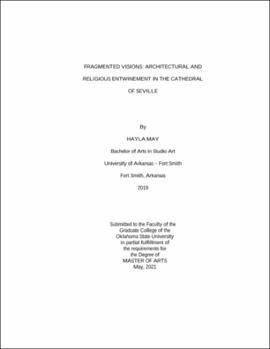| dc.contributor.advisor | Borland, Jennifer | |
| dc.contributor.author | May, Hayla | |
| dc.date.accessioned | 2021-09-24T13:58:07Z | |
| dc.date.available | 2021-09-24T13:58:07Z | |
| dc.date.issued | 2021-05 | |
| dc.identifier.uri | https://hdl.handle.net/11244/330933 | |
| dc.description.abstract | This study analyzes the affectivity of the Cathedral of Seville on its fifteenth and sixteenth century audiences through a phenomenological assessment of spatial experience on its viewer. In so doing, I contend that the space simultaneously influenced and reflected social contentions at a time in Spain that was fraught with religious discord between Christians and Muslims. I trace the history of the site, beginning with the construction of the Great Mosque in the twelfth century, move through its reconsecration as a cathedral in the thirteenth century and reconstruction into a Gothic building in the fifteenth and sixteenth centuries. Through the chronology, I question the role of the cathedral as a symbolic tool that narrated religious conquest and how that function of the space influenced socioreligious relationships. By employing a close formal analysis of the disorienting juxtaposition of Almohad and Gothic aesthetics, I demonstrate that Castilian governance of the space specifically utilized contrasting visual motifs in a system that reiterated Catholic dominion over the once-Islamic sacred space. The demolition of the prayer hall of the reconsecrated mosque in the fifteenth century directly reflected the simultaneous fracturing of Muslim communities in Castilian Spain; customs, behaviors, and livelihoods were regulated by law and their communities became fractured by the entwinement of the socioreligious groups in the city. Using the approach of reception theory of the cathedral against the anthropological backdrop of sixteenth century Iberia, I argue that the timing of the cathedral reconstruction was affected by changing sentiment about the threat of Islam to the Catholic kingdom of Castile, and that the newly reconquered cathedral participated in a system of increasing hegemony against Muslims in Spain. | |
| dc.format | application/pdf | |
| dc.language | en_US | |
| dc.rights | Copyright is held by the author who has granted the Oklahoma State University Library the non-exclusive right to share this material in its institutional repository. Contact Digital Library Services at lib-dls@okstate.edu or 405-744-9161 for the permission policy on the use, reproduction or distribution of this material. | |
| dc.title | Fragmented visions: Architectural and religious entwinement in the Cathedral of Seville | |
| dc.contributor.committeeMember | Siddons, Louise | |
| dc.contributor.committeeMember | Graham, Emily | |
| osu.filename | May_okstate_0664M_17211.pdf | |
| osu.accesstype | Open Access | |
| dc.type.genre | Thesis | |
| dc.type.material | Text | |
| dc.subject.keywords | cathedral | |
| dc.subject.keywords | early modern | |
| dc.subject.keywords | iberia | |
| dc.subject.keywords | phenomenology | |
| dc.subject.keywords | religions | |
| dc.subject.keywords | seville | |
| thesis.degree.discipline | Art History | |
| thesis.degree.grantor | Oklahoma State University | |
